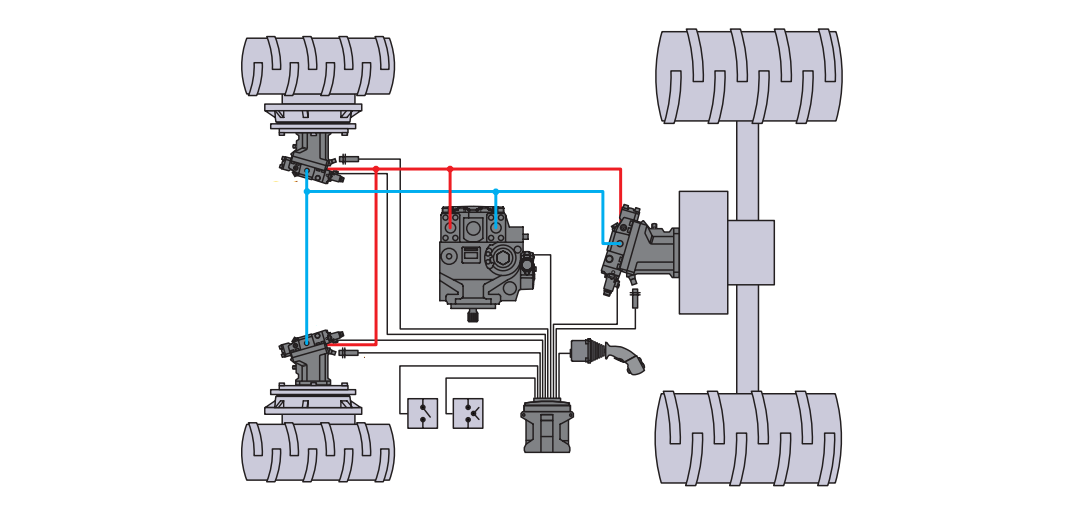Hydraulic Drive Troubleshooting
There are many reasons why hydraulic drives can fail. Proper start-up and break-in are essential to ensure long-term trouble-free operation of hydraulic drives. Often, many systems, especially pumps, fail after only a few hours of operation, while others fail after a few minutes, all because the most basic operations are missed. For example, due to inattentiveness to cleaning rules before and during launch. Additionally, all moving parts generate wear particles during the break-in process. Therefore, it is important not to fully load the system until all this dirt has been filtered out.
To prevent failure of hydraulic drives and their components, Danfoss has established 3 basic rules as follows: “1. Purity. 2. Cleanliness. 3. Cleanliness.
Rule 1 concerns cleanliness during hydraulic system installation. Once manufactured, hoses, pipes and fittings must be cleaned immediately prior to installation by blowing compressed air through a cork tube made of crepe paper or a lint-free cloth soaked in paraffin. This process must be repeated several times until a completely clean cork comes out.
Rule 2 concerns the cleanliness of the hydraulic system during daily operation. The main goal is to prevent oil contamination. This requires filters (including air filters) to be cleaned. Piston rod, shaft and shaft seal must be kept clean. The device used for oil injection must of course also be clean, and the oil injected into the system must also pass through the same finely cleaned filter.
Rule 3 refers to cleanliness during inspection and maintenance. Before removing threaded connections, all loose paint must be removed and all opening parts, pipes, hoses, etc. must be covered, e.g. bundled in plastic bags. This is necessary so that dirt does not enter the system during forced shutdowns.

Noise in hydraulic pump
Possible Cause Solution
1. The hydraulic pump is not supplied with oil or is not supplied with enough oil. 1. Clean the suction filter. Check the suction line for damage or restriction.
2. The viscosity of the oil is too high. 2. Check the oil. Adjust viscosity to operating temperature.
3. Hydraulic pump sucks air:
a) Through the hydraulic pump shaft seal
b) by loose or damaged suction line
c) Oil level too low
d) The air in the tank is saturated (oil overflows the pipe above the tank level from the return). 3. Replace the shaft seal. Tighten the fitting or replace the suction tube. Change the oil and fill with clean oil. Install the return line 5-8 cm below the surface and as far away from the suction line as possible.
4. The hydraulic pump is worn. 4. Repair or replace the hydraulic pump.
5. The rotational speed is too high. 5. Adjust the speed.
6. The oil pressure is too high. 6. Adjust the oil pressure.
no pressure
Possible Cause Solution
1. The oil level is too low 1. Change the oil - inject clean oil.
2. The hydraulic pump does not work or the working direction is wrong. 2. Set the correct rotation direction. Check drive belt or clutch.
3. Relief valve stuck open. 3. Repair the unloading valve.
4. Hydraulic pump failure, broken shaft or rotor key. 4. Repair the hydraulic pump.
no stress or instability
Possible Cause Solution
1. The working pressure is too low 1. Check the pressure correction valve.
2. Leakage of pressure correction valve or control valve. 2. Repair the valve.
3. Part of the oil flows back to the tank through the faulty valve or cylinder. 3. Repair the cylinder or valve.
Noise in safety valve
Possible Cause Solution
1. Excessive consumption. 1. Install a valve that matches the actual oil flow.
2. Dirt or debris between cone and seat. 2. Repair the valve.
Air in the system, foam in the oil
Possible Cause Solution
1. Suction line leaks. 1. Repack or replace the tubing.
2. The resistance of the suction line is too large. 2. Clean filter or suction pipe or replace with larger pipe. Check accessories.
3. Oil spilling from the return line above the tank level - this can cause blistering. 3. Remove the oil return pipe from the suction pipe and lengthen the oil return pipe if necessary.
4. Using the wrong type of oil. 4. Oil Change - Fill with the correct type of oil.
system overheating
Possible Cause Solution
1. No cooling water supply. 1. Restore the cooling water supply.
2. The oil cooler is clogged or dirty. 2. Clean the oil cooler.
3. Oil viscosity increases. 3. Change the oil to the correct type.
4. The internal leakage of a component is abnormal. 4. Repair or replace defective system components.
5. Change working conditions. 5. Install additional cooling if necessary
6. Hydraulic pump, valve or motor overload. 6. Reduce the load or install stronger elements.
The hydraulic motor speed is lower than the calculated value
Possible Cause Solution
1. The hydraulic pump is worn. 1. Repair or replace.
2. The hydraulic pump speed is too low. 2. Adjust the speed.
3. The hydraulic motor is worn. 3. Repair or replace the hydraulic motor.
4. The oil temperature is too high (resulting in increased internal leakage of the engine, valves, etc.). Ambient temperature may be too high. 4. Install an oil cooler or increase the capacity of an installed cooler or oil tank. Change the oil and add a higher viscosity oil.
5. Insufficient pipe diameter, etc. 5. Install larger pipes.
6. Cavitation in hydraulic pump. 6. Look at the question "Hydraulic pump is noisy".
7. The set pressure of the safety valve is too low. 7. Adjust the valve to the correct pressure.
8. Control valve leaking. 8. Repair the valve.
9. The hydraulic motor is overloaded. 9. Eliminate the cause of overload or install a larger hydraulic motor.